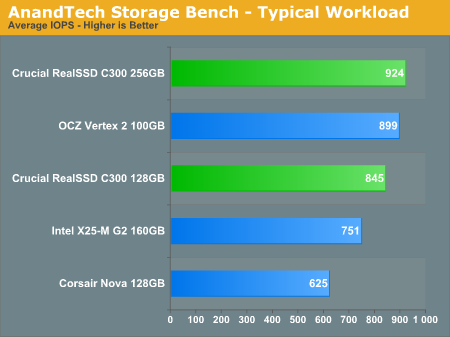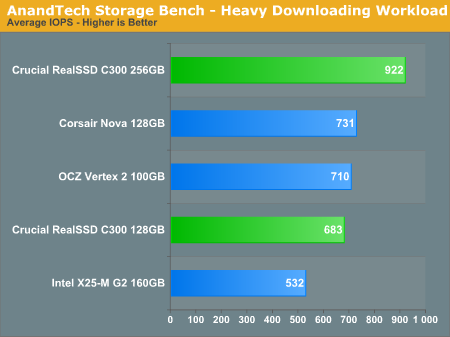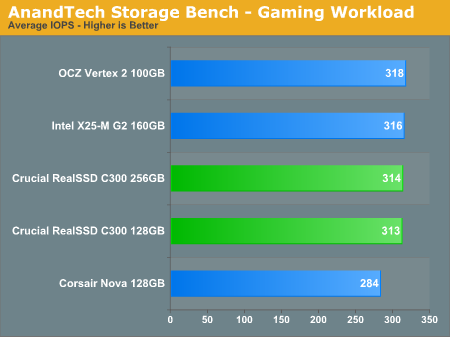The SSD Diaries: Crucial's RealSSD C300
by Anand Lal Shimpi on July 13, 2010 12:39 AM ESTAnandTech Storage Bench
The first in our benchmark suite is a light usage case. The Windows 7 system is loaded with Firefox, Office 2007 and Adobe Reader among other applications. With Firefox we browse web pages like Facebook, AnandTech, Digg and other sites. Outlook is also running and we use it to check emails, create and send a message with a PDF attachment. Adobe Reader is used to view some PDFs. Excel 2007 is used to create a spreadsheet, graphs and save the document. The same goes for Word 2007. We open and step through a presentation in PowerPoint 2007 received as an email attachment before saving it to the desktop. Finally we watch a bit of a Firefly episode in Windows Media Player 11.
There’s some level of multitasking going on here but it’s not unreasonable by any means. Generally the application tasks proceed linearly, with the exception of things like web browsing which may happen in between one of the other tasks.
The recording is played back on all of our drives here today. Remember that we’re isolating disk performance, all we’re doing is playing back every single disk access that happened in that ~5 minute period of usage. The light workload is composed of 37,501 reads and 20,268 writes. Over 30% of the IOs are 4KB, 11% are 16KB, 22% are 32KB and approximately 13% are 64KB in size. Less than 30% of the operations are absolutely sequential in nature. Average queue depth is 6.09 IOs.
The performance results are reported in average I/O Operations per Second (IOPS):

In our custom test suite we can finally put to rest concerns about the real world behavior of SandForce’s drives. Our light test case makes it pretty clear: in practice the Vertex 2 performs within 3% of the 256GB C300, and is a good 20% faster than the Intel X25-M G2. Keep in mind that we’re looking at raw IO performance and not total system performance here.
If there’s a light usage case there’s bound to be a heavy one. In this test we have Microsoft Security Essentials running in the background with real time virus scanning enabled. We also perform a quick scan in the middle of the test. Firefox, Outlook, Excel, Word and Powerpoint are all used the same as they were in the light test. We add Photoshop CS4 to the mix, opening a bunch of 12MP images, editing them, then saving them as highly compressed JPGs for web publishing. Windows 7’s picture viewer is used to view a bunch of pictures on the hard drive. We use 7-zip to create and extract .7z archives. Downloading is also prominently featured in our heavy test; we download large files from the Internet during portions of the benchmark, as well as use uTorrent to grab a couple of torrents. Some of the applications in use are installed during the benchmark, Windows updates are also installed. Towards the end of the test we launch World of Warcraft, play for a few minutes, then delete the folder. This test also takes into account all of the disk accesses that happen while the OS is booting.
The benchmark is 22 minutes long and it consists of 128,895 read operations and 72,411 write operations. Roughly 44% of all IOs were sequential. Approximately 30% of all accesses were 4KB in size, 12% were 16KB in size, 14% were 32KB and 20% were 64KB. Average queue depth was 3.59.

Our heavy downloading workload involves more heavily compressed files and thus we see the Vertex 2 perform like a 128GB C300. The 256GB C300 just can't be touched.
The gaming workload is made up of 75,206 read operations and only 4,592 write operations. Only 20% of the accesses are 4KB in size, nearly 40% are 64KB and 20% are 32KB. A whopping 69% of the IOs are sequential, meaning this is predominantly a sequential read benchmark. The average queue depth is 7.76 IOs.

Our gaming workload has been SATA bound for the high end SSDs for some time now. If you happen to be baller enough to play games off of an SSD, any of these high end drives will perform the same. Although our custom tests don't work with the 6Gbps Marvell controller, the boost to sequential read speed should be quite visible in gaming workloads with the C300.










51 Comments
View All Comments
Thevilpsycho666 - Sunday, February 6, 2011 - link
Hi !After reading Anand reviews on the c300, i was amazed by the performance of the drive even for the 128gb model and since i have a Rampage III gene with a 6gb Marvell 9128 controller i was thinking of buying one.
Finally 3 days ago the drive was 250$ on newegg so i bought it.
Going around on forum i discover with great disappointment that the 6gbs Marvell controller "apparently" don't issue the TRIM command, is it true ?
Nobodies seem to have a definitive answer, Crucial don't have one, Marvell are under NDA so they don't answer anyone, Asus Told somebody that they should use the Intel controller instead to ensure TRIM support.
1- Is the Marvell controller supporting Trim and is there a way to test that ? (the "fsutil behavior query DisableDeleteNotify" command is not the answer because it's only telling if the OS is issuing the command and that's not where the problem is.)
2- Some Claim that with the latest Marvell driver which is 1.0.00.1051 make the TRIM working. Some claim that it don't.
3-Other claim that the Microsoft ACHI drivers instead of Marvell's one work with TRIM.
It would be very nice if you Anand could test that particular scenario (C300 With Marvell 9128 6gbs windows 7 64) To see if the TRIM command work.
In the end not only me will benefit, but the whole community as well.
Thank you in advance!